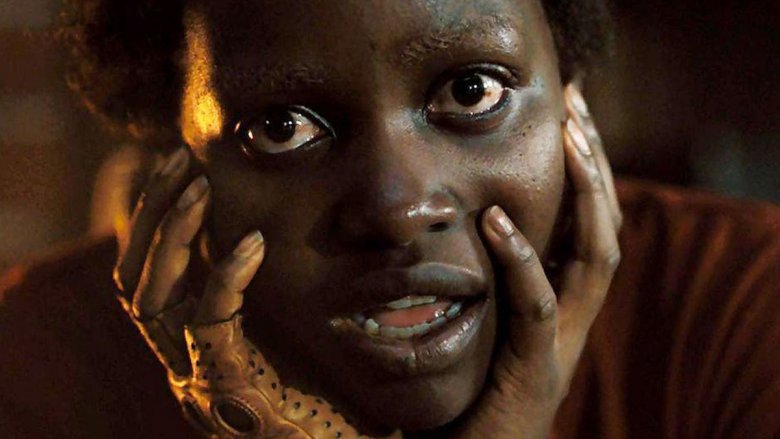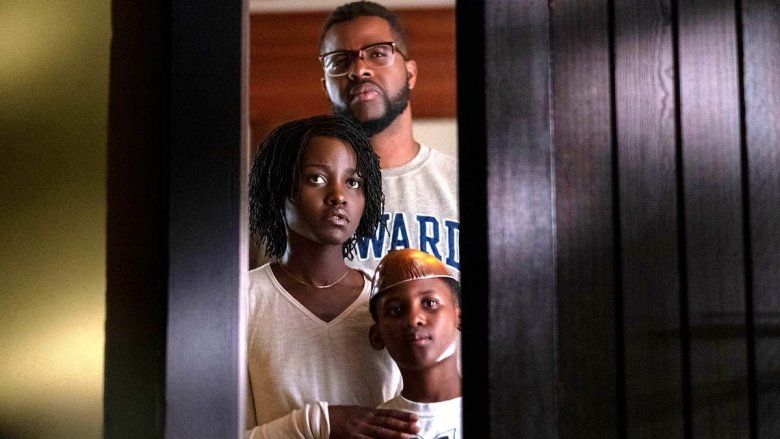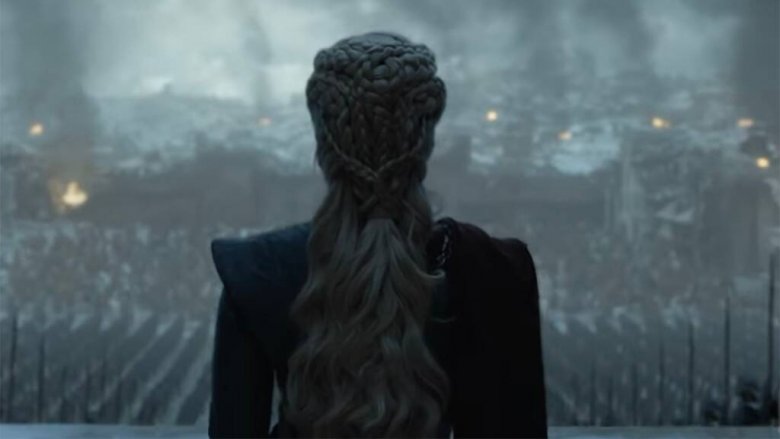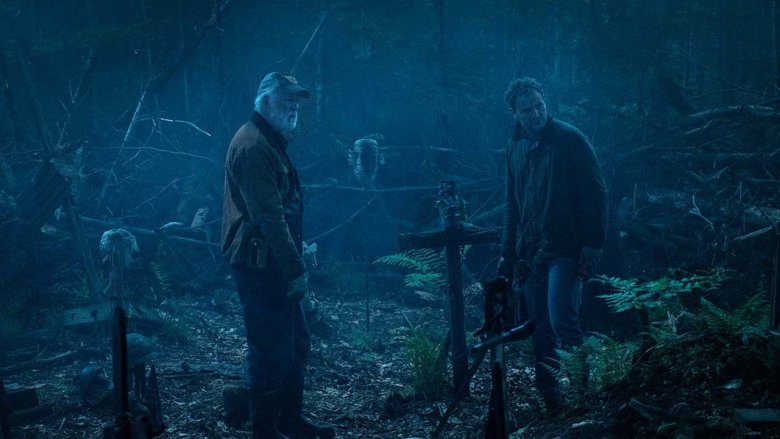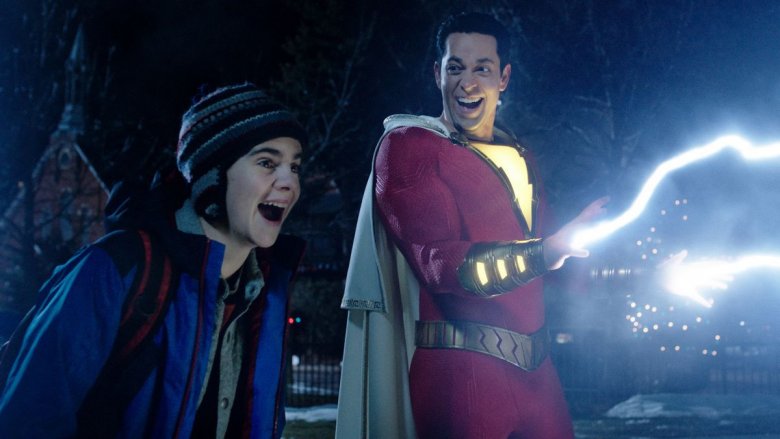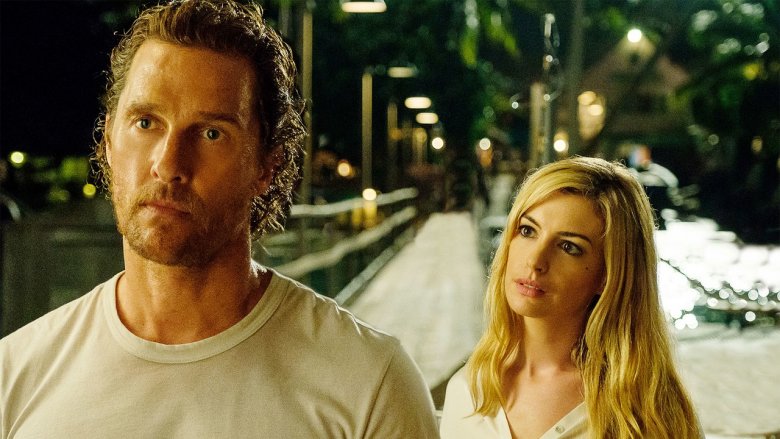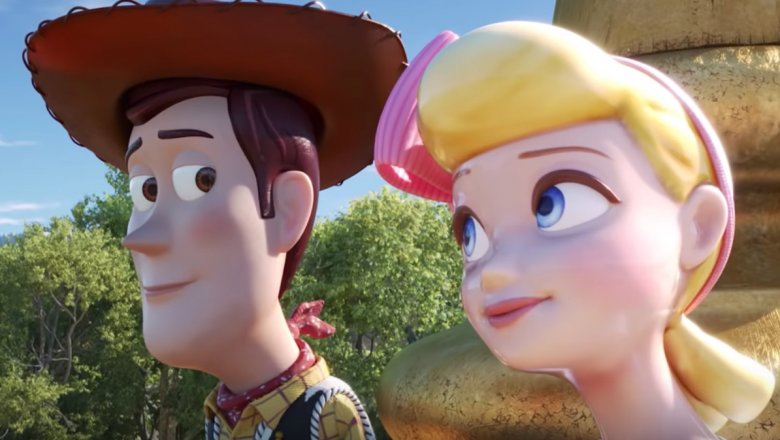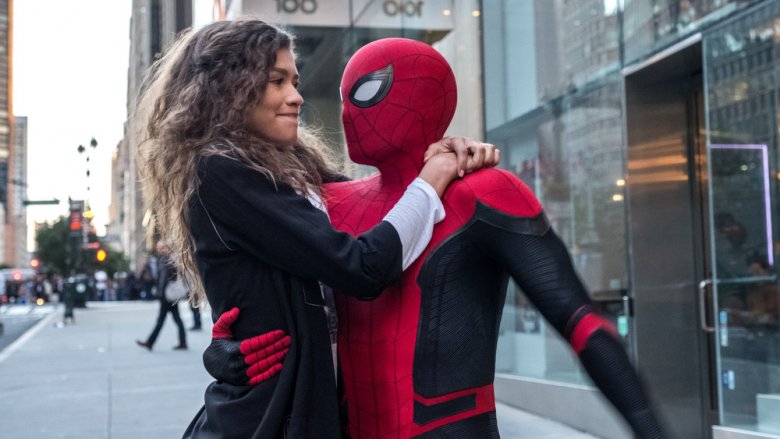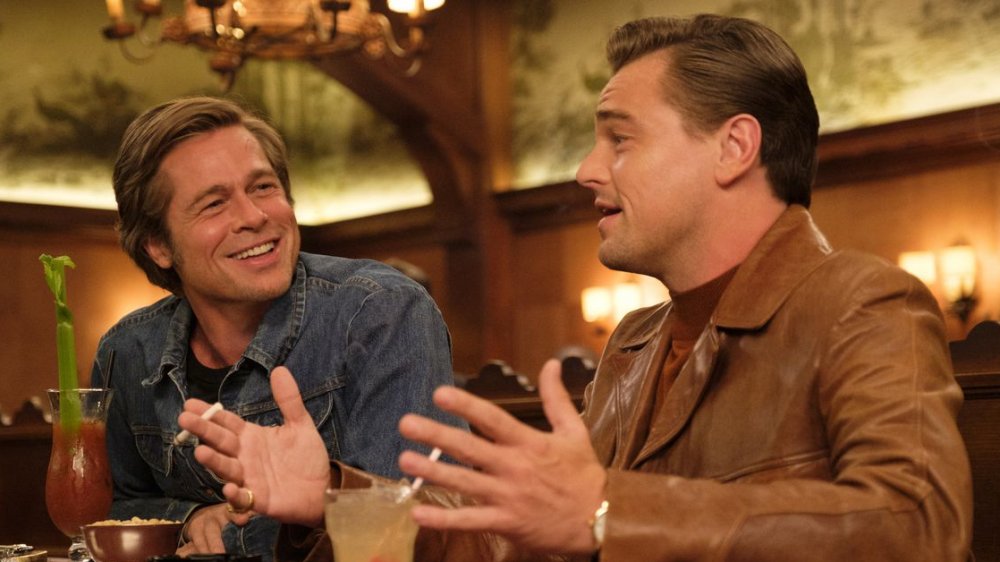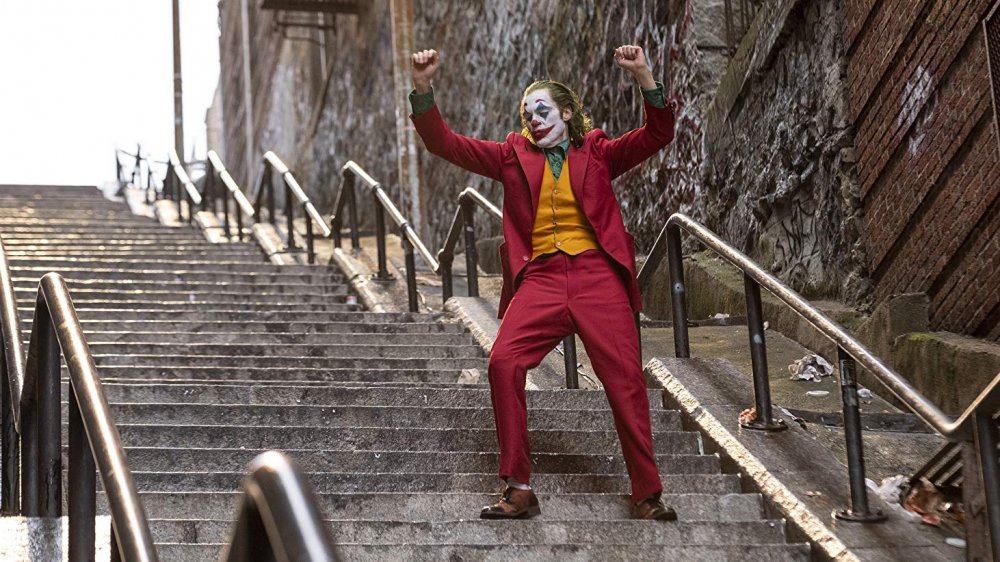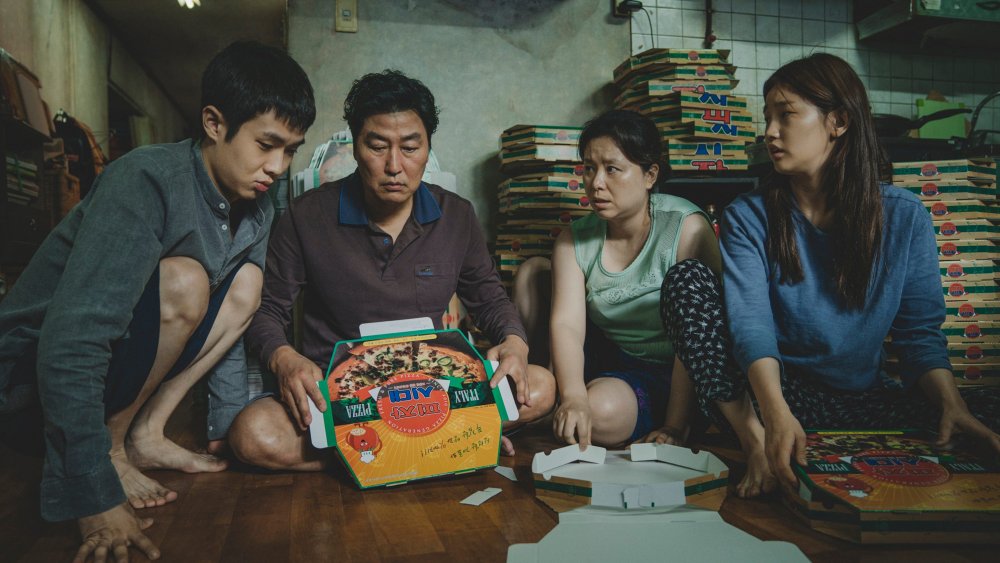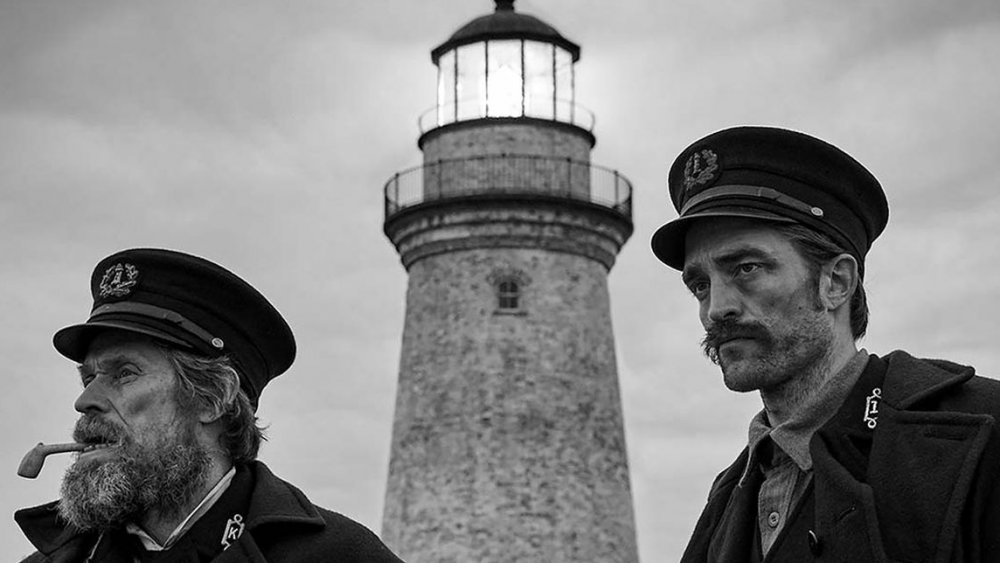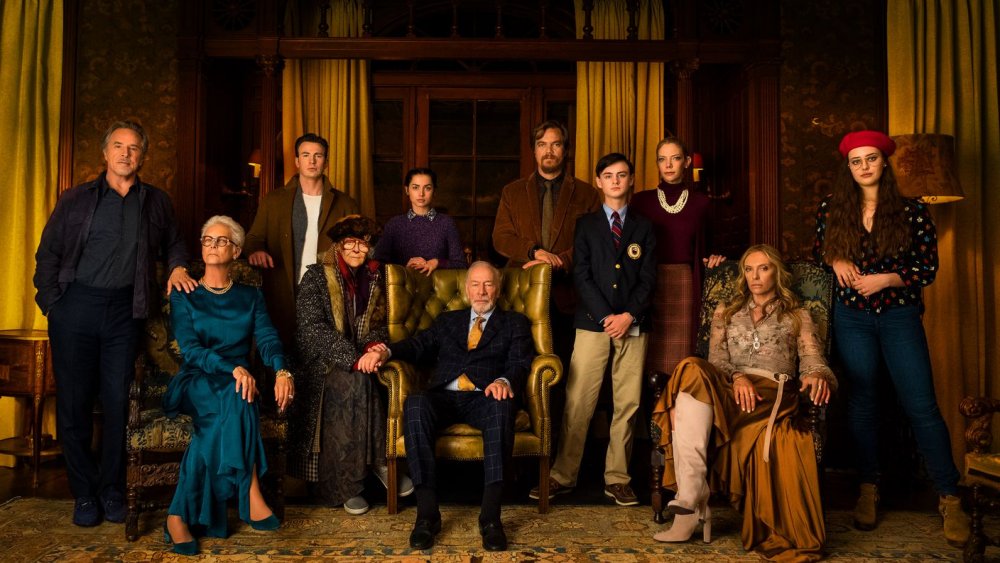The Biggest Plot Twists Of 2019
Plot twists can make a good movie great, a great movie legendary, a bad movie good, and a terrible movie something unforgettable. Not all movies and TV shows call for them, but when they land with just the right level of gravity, they stick in our brains to the point that they might be the only thing we remember about a given story years later. Twists are to be used wisely — but even if you're not going to use them wisely, you should at least use them to make your story weird enough to be remembered.
It's been a big year for twist endings. So far we've seen heroes turn into villains, villains turn into allies, secret societies at work, life-altering decisions, and even one movie that turned out to partially take place in a video game. These are the biggest plot twists of 2019 so far.
SPOILERS AHEAD for every film and show on the list. You've been warned.
Us and the Tethered twist
The marketing for Us presented it as a home invasion thriller with a dark secret, and the mystery was in unraveling exactly what that secret was. The film begins with a title card describing thousands of miles of tunnels with "no known purpose" beneath the United States, and then spends much of its runtime never really explaining why that was brought up.
Then the twist comes — or what we think is the twist, as Red (Lupita Nyong'o) explains the nature of the Tethered and why she decided to stage an uprising for her people. It's a twist, of sorts, but it's really more of an explanation.
Then the real twist arrives at the very end of the movie, when Adelaide (also Nyong'o) realizes via a long-repressed memory that she's actually the Tethered one, and that Red was her original self, who she strangled and hid down in the tunnels so she could attempt to live a normal life. In retrospect it explains so much, but even if some viewers guessed it from the beginning, watching it all build to that moment remains intensely satisfying.
Game of Thrones' Bells tolled for a big plot twist
There are a number of exciting developments in the much-anticipated and divisive final season of Game of Thrones which could be considered important twists. There's the decision to name Bran Stark King of the Six Kingdoms, which was itself followed almost immediately by the revelation that the North would secede and become an independent kingdom ruled by Sansa Stark, which was then followed by Jon Snow's exile beyond the Wall (where his Targaryen heritage doesn't matter) and Arya Stark's decision to journey in search of what's west of Westeros.
If we're talking about truly massive twists, though, we have to talk about the Mad Queen, and the fall of Daenerys Targaryen. Though it had been foreshadowed in various ways throughout the series, Dany's turn from righteous crusader for the oppressed to full-on genocidal dragon rider happened so quickly in the midst of the show's six-episode final season that many fans were caught off guard and flat-out angry about it. The episode in which she reached a point of no return, "The Bells," is one of the most harrowing moments in the entire series, and some viewers still have their jaws on the floor.
Glass
In 2016, M. Night Shyamalan pulled off what might be the biggest twist of his career with the surprise reveal that his thriller Split — about a man with multiple personalities who kidnaps a group of girls — was actually a secret sequel to his 2000 classic Unbreakable. Glass is a follow-up to both films that brings together the heroes and villains of each story into one superhero universe. Because this is a Shyamalan movie, though, Glass couldn't exactly be that straightforward.
It turns out that Kevin Wendell Crumb, a.k.a. the Horde (James McAvoy), and David Dunn, a.k.a. The Overseer (Bruce Willis), are not the most powerful forces in their world. As their final clash is underway, Shyamalan reveals that they were brought together not to be studied or to be revealed as gifted to the world, but to be executed by a secret society determined to keep the balance in the world by wiping out special people.
Then, of course, Shyamalan couldn't help but throw in another twist by making the brilliant Mr. Glass (Samuel L. Jackson) construct a counter-scheme that resulted in proof of superheroes being released to the world, establishing the potential for an even bigger universe. M. Night Shyamalan's been playing this game for decades now, and he knew one twist just wouldn't be enough.
Avengers: Endgame goes for the head -- and a big plot twist
Avengers: Endgame was only ever going to end one way: with the Avengers finding a path to defeating Thanos and restoring their snapped-out friends to life within the Marvel Cinematic Universe after the events of Infinity War. We knew that going in. The only mystery was in how it would happen, and it's there that the film threw viewers for a loop just a few minutes into the adventure.
The stage was set for an Avengers vs. Thanos rematch almost right away, but when the surviving members of Earth's Mightiest Heroes got to him, Thanos revealed that he'd already destroyed the Infinity Stones. Their plan to get them back was thwarted. So Thor simply beheaded Thanos, and before we could even get over the shock of that death, the film jumped ahead five years to show a seemingly doomed world.
With the rug pulled out from underneath moviegoers, the film could then move on into its real story, but not before completely shattering expectations by killing off the villain in the first half hour.
Pet Sematary's creepy twists
The 2019 film adaptation of Stephen King's Pet Sematary didn't attempt to hide its major alterations to the source material. Some of the film's earliest trailers gave away that the new movie was going to make the Creed family's eldest child, Ellie, the victim of a tragic early death that would drive her father to bury her in the pet cemetery — unlike King's book, which kills off the family's youngest child, Gage. It was a big change that seemingly allowed the filmmakers more leeway to play with the psychological terror of such a tragedy while also upping the violence factor of the undead child. It was also a brilliant bait and switch hiding the film's real twist.
The original story ends with Louis Creed's killer undead son murdering his neighbor and his wife, which then drives Louis to bury the latter in the cemetery to bring her back as an undead ghoul as well. In the new film, the undead Ellie kills both her mother and father and buries them in the cemetery, and then the trio of undead Creeds descends on young Gage as the movie ends. It ups the horror quotient of the film's final minutes quite a bit, and while not all fans will agree with the new direction, there's little doubt that few of us saw it coming.
Shazam! keeps it in the family
Shazam! follows many of the traditional superhero origin story paths in telling the tale of Billy Batson and his journey from orphan boy to impossibly powerful superhero who can transform with the simple use of the magic word. We see Billy learning to use his new powers in a mature way, his connection to the people who become his chosen family, and his defeat of the supervillain Sivana not just through brawn, but through the power of love.
Where the twist comes in is the way that love manifests itself. In the midst of his final battle with Sivana, Billy remembers the wizard who gave him his powers said something about sharing it, and realizes he must pass his gifts onto this chosen family. And that's how, in 2019, we got the Shazam Family on the big screen. It's not exactly a twist in the classic sense, but it is something that was very hard to see coming, because it always felt like sequel fodder. The film's willingness to put such a massive new development out there so late in the story was part of what made it so much fun.
Serenity: a game of twist-er
Serenity came and went as a blip on the screen in the midst of a crowded year for movies, despite boasting a cast that includes Oscar winners Matthew McConaughey and Anne Hathaway. If you did hear about this film without having seen it for yourself, it's because it managed to somehow pack an absolutely bonkers twist into what looked like a standard neo-noir film on the surface.
See, Serenity is the story of a fisherman and boat captain (McConaughey) who's obsessed with catching a big tuna who always seems to avoid him. His relatively boring life is changed when his ex-wife (Hathaway) shows up and offers him a ton of money to kill her abusive new husband. So far, all the ingredients for a nice little thriller are there.
And then it turns out this is all happening inside a video game.
That's right, the story of Serenity is actually that a 13-year-old boy has programmed a video game as a therapeutic exercise to reconnect with his dead father — only then he decides to change the game's programming when he realizes he wants to kill his abusive stepfather. Then things get even weirder when the game itself seems to want to deny its own programming and somehow prevent the murder. Yes, this is a real movie.
Toy Story 4 plot twists to infinity and beyond
Sheriff Woody (Tom Hanks) spends much of the runtime of Toy Story 4 lecturing trash-turned-toy Forky (Tony Hale) on the many benefits and responsibilities that come with being loved by a child. He does all this in the midst of a road trip which, of course, leads to all manner of adventures for the toys, including a reunion with long-lost Bo Peep, who's happily living out her days as a toy without a kid.
The twist in Toy Story 4 doesn't arrive until the very end, but like so much else in this franchise it's an emotional gut punch. After spending the whole adventure trying to teach Forky what it means to be a toy, Woody realizes he can help another toy, Gabby Gabby, to finally achieve her lifelong dream of being united with a child, something she'd spent decades unable to do. It's in this moment that Woody realizes he has a new purpose: Not to make his kid, Bonnie, happy, but to make other toys and other kids happy. He makes the last-minute decision to stay behind with Bo, while Buzz and the gang go back to Bonnie's house. It's a massive, heartwarming change to the status quo of the franchise, and while we might never see how it plays out in terms of Woody's future, it was a gutsy way to send him off.
Spider-Man: Far from Home
You'd think the biggest twist in Spider-Man: Far From Home would come from Mysterio, the man who claims to be a hero from another Earth but who's actually a villain from our own world, using super-advanced illusion tech to trick everyone into thinking he's fighting off city-destroying monsters. The trouble is, a lot of people guessed that twist just from watching the film's trailers and understanding that Mysterio is the kind of guy who's historically been good at doing exactly that. So, where's the real twist?
To get blockbuster levels of shock from this film, you have to stick around until the mid-credits scene, when it's revealed that Mysterio doctored a video before his death to make Spider-Man look like the true villain of their struggle, while also outing Peter Parker as the man in the mask. This sudden change in the character's status quo, plus the sudden return to the Spider-Man universe of J.K. Simmons as J. Jonah Jameson, is enough to make people shout at the screen in shock — and then in the next post-credits scene, it's revealed that Nick Fury and Maria Hill have been replaced by shape-shifting Skrulls. To top it all off, they're impersonating the crimefighting duo on Fury's orders — as seen when Fury disconnects their call from what looks like a tropical beach, but is actually a sort of holodeck on a Skrull vessel in deep space.
Once Upon a Time in... Hollywood
When Quentin Tarantino released his World War II epic Inglourious Basterds, no one was necessarily expecting that he would write a pivotal change to history into the script, but that's exactly what happened. Tarantino had his heroes gun down Hitler in a Paris movie theater, and ever since then we've been wondering what other major changes he might slip into period dramas.
Once Upon a Time in... Hollywood presented plenty of opportunities for Tarantino to once again play fast and loose with a true story. Set in 1969 Hollywood, the film shows us a history of a tipping point within both the film industry and Los Angeles as a whole. There's a sense of a city and an art form on the brink, and Tarantino successfully creates the feeling that anything might happen. Then, as the film reaches its climax, he drops the big twist.
It turns out that anything-can-happen feeling is there to set up Tarantino's dream version of events: a world in which Sharon Tate and her friends are never murdered by the Manson Family, and the Family members are instead fought off by Cliff Booth and Rick Dalton. Sharon survives, Rick gets another shot at a career, and Cliff is along for the ride. It's a bittersweet happily ever after, and one that lands even if you do sorta see it coming.
Joker
At first glance, Joker doesn't seem like a movie that's too interested in playing with the many comic book inspirations it could draw from. The film is named after and based on the DC Comics character of the same name, of course, but that doesn't mean it has to play by DC Comics rule. That's how we get things like the gritty early '80s aesthetic and the story partially drawn from films like The King of Comedy. It's also how we get an R-rated drama that takes itself very seriously, but not so serious that it's not interested in continuity.
There are two major twists in Joker, and both are presented in a way that creates a certain sense of ambiguity so that you're not sure who to believe. The first arrives when it's revealed that Arthur Fleck might actually be the illegitimate son of Thomas Wayne himself, which makes him Bruce Wayne's half brother. Doubt is later cast on this claim, but Arthur seems to cling to it, and that attachment pays off later. The film's ending drops the second major twist: the riot Arthur Fleck inspired created the environment in which Bruce Wayne's parents were killed. So, in the continuity of this movie, the Joker inadvertently creates Batman. Does this make the film too twisty for its own good? Your mileage may vary, but there's no doubt you left the theater thinking about it.
Parasite
Bong Joon-ho's Parasite is a film that succeeds for many reasons, from the way it infuses class conflict into its thriller framework to the spot-on performances of the entire ensemble. One of the biggest keys to the film's success, though, is the way it lulls you into thinking everything's going to go one way before zipping off in another, unexpected direction. This is best exemplified by the major turn that comes midway through the film, just after the Kim family has thoroughly infiltrated the Park family's lives.
At this point, Bong has expertly planted the seeds for what we think is about to happen, which is the Park family's slow discovery that the Kim family have conned them. Then the doorbell rings, and the fired housekeeper who we never expected to see again shows up, giggling and bloody. Her performance in the moment, helped along by pouring rain, is so unsettling and strange that we genuinely have no idea what's about to happen. When she finally enters the Park house again, and reveals the secret bunker beneath the structure, the whole theater is suddenly sitting on a new edge they didn't know the film had. It's a brilliant turn that both subverts expectations and fits perfectly within the film's framework.
The Lighthouse
If you walk out of The Lighthouse and someone asks you, "Hey, what's The Lighthouse about?" there's a good chance you'll have some difficulty explaining, even if you've just seen it. Yes, it's the story of two lighthouse keepers who seem to be slowly losing their grip on sanity and reality, but if you really dig into the intricacies of the film, it's a lot more complicated. It's not a plot-heavy story, and relies much more on atmosphere and the unreliability of each character's perspective to carry its unnerving tone.
That said, there's still a powerful twist lying in wait near the end of the film. It comes when the young wickie Ephraim Winslow (Robert Pattinson) reveals that his real name is Thomas Howard, and that Winslow was an identity he stole from a man who died in a timber accident that he didn't stop. This revelation, and the guilt that comes with it, helps to add tremendous depth and emotional weight to the film's powerful climax. As Thomas descends deeper into madness, we get the sense that he's after both self-destruction and redemption, and we're not sure which one the lighthouse will ultimately give him.
Knives Out
Knives Out is set up as a classic cozy mystery story, a whodunit in the grand tradition of Agatha Christie that features an ensemble cast, a memorable central setting, and of course, a brilliant detective out to discover the truth. That set-up, and the particular subgenre the film is working in, provides ample opportunities for twists and turns within the story, and writer/director Rian Johnson delivers more than one.
In terms of the biggest plot twist at work in Knives Out, though, we have to talk about the death at the heart of the piece. The victim is Harlan Thrombey, a noted mystery writer who's found dead of an apparent suicide at the beginning of the film. Throughout the course of the film, private investigator Benoit Blanc tries to prove that Harlan was murdered, but the truth is much more complicated.
Johnson eventually reveals that Harlan did technically commit suicide, after his nurse Marta accidentally gave him what she believed to be a fatal dose of morphine. Harlan killed himself rather than risk Marta getting arrested for a simple mistake, but it turns out there was even more to the story. In the end, Blanc reveals that Harlan's grandson Ransom actually switched the labels on Harlan's medication to engineer the morphine overdose, but Marta gave Harlan the right medication out of instinct. So, the twist in the end is that there's not a murder of any kind. Harlan's death really was just a misguided suicide.
